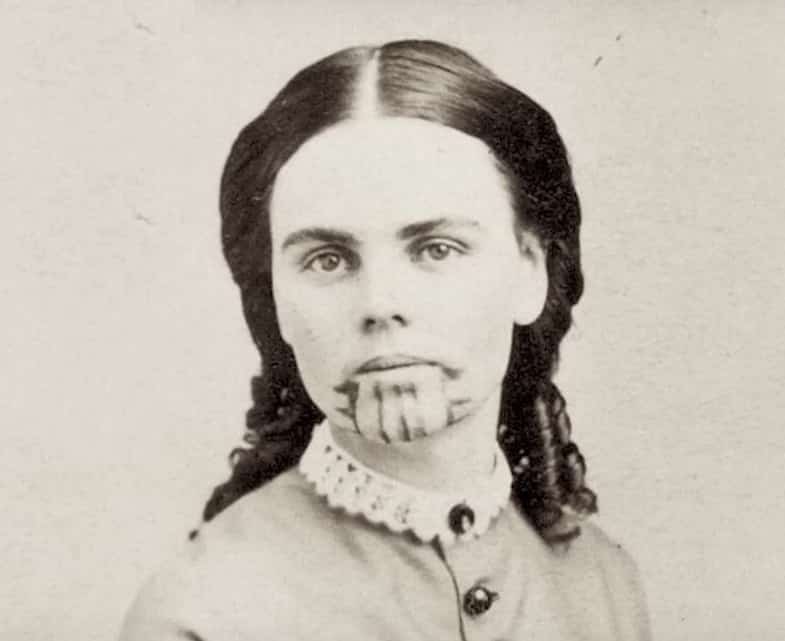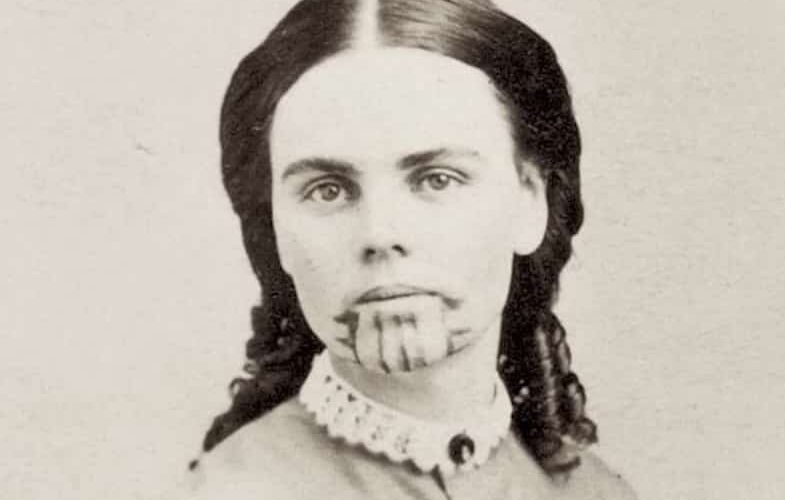Olive Oatman & the Blue Tattoo

Olive Oatman’s life is one of the most extraordinary tales from the American West.
As a young pioneer, she was taken captive by Native Americans and later returned to her original society, bearing unique tattoos that made her a figure of both curiosity and tragedy. Her story is far from simple and is a compelling mix of survival, cultural adaptation, and the challenges of reintegration.
The Oatman Family and Their Pioneer Dreams
The Oatman family were Mormon pioneers searching for a better life in the west. In 1850, they joined a group called the Brewsterites, led by James C. Brewster. Brewster claimed he received divine messages directing his followers to build a city called “Bashan” in the Rio Grande Valley. However, disagreements among the group caused many to split and head toward California, including the Oatmans. The family, originally from Illinois, consisted of Royce Oatman, his wife Mary Ann, and their seven children. Unfortunately, their journey would end in tragedy before they reached their destination.
A Dangerous Decision to Travel Alone
After leaving the main group in New Mexico, Royce Oatman took charge of a smaller faction. They faced harsh conditions, including difficult terrain, dwindling supplies, and threats from hostile tribes. At Maricopa Wells, Arizona, locals warned the Oatmans about the dangers ahead, including attacks by the Quechan tribe. Most of the group chose to stay, but Royce decided to push forward with just his family.
Royce’s concerns about their lack of food and vulnerability played a part in his decision to move on. Sadly, this choice would leave the Oatmans isolated and exposed to danger.
The Oatman Massacre
In February 1851, the family was attacked near the Gila River. Olive later described the event in accounts like the 1857 book Captivity of the Oatman Girls. A group of Native men approached the family, initially sharing a meal with them. However, tensions rose when Royce refused to provide more food. The encounter turned violent, and the men attacked the family, killing Royce, Mary Ann, and five of the children.
Only 14-year-old Olive and her 7-year-old sister Mary Ann survived. Their teenage brother Lorenzo was severely injured but managed to escape. He later returned with help to bury the dead but found no trace of his sisters.
Captivity Among the Yavapai
After the attack, Olive and Mary Ann were taken captive by the Yavapai tribe. Life with the Yavapai was difficult, as they were forced into labor and beaten for disobedience. Such treatment was not uncommon, as some tribes took captives for ransom, revenge, or to replenish their numbers after losses.
The sisters spent about a year with the Yavapai before their lives changed once again.
Adopted by the Mohave Tribe
The sisters were eventually traded to the Mohave tribe. According to Olive, Topeka, the daughter of the Mohave chief Espaniole, felt sympathy for the girls and arranged the trade. Unlike their time with the Yavapai, life with the Mohave was kinder. The girls were welcomed into the tribe, given food, and treated as family. Olive and Mary Ann even received traditional Mohave tattoos, which were considered important for spiritual recognition in the afterlife.
Despite this, Olive would later claim in some accounts that she was held against her will, though evidence suggests she became integrated into Mohave society.
The Tragic Loss of Mary Ann
In 1855, a poor harvest brought famine to the Mohave. Food became scarce, and many in the tribe, including children, succumbed to starvation. Mary Ann, already weakened, did not survive. Olive mourned her sister deeply, believing she was the last surviving member of her family. However, the Mohave women, including Topeka and Espaniole’s wife Aespaneo, supported Olive through her grief and ensured Mary Ann was given a proper burial.
Olive’s Return to White Society
In 1856, rumors of a white woman living with the Mohave reached Fort Yuma. A Quechan messenger named Francisco informed the Mohave that they were in danger if they did not release Olive. Fearing retaliation, the tribe reluctantly allowed Olive to leave. Mohave leaders expressed sadness at her departure, as Olive had become part of their community.
Olive was escorted to Fort Yuma, where she was reunited with her brother Lorenzo. Her return drew significant public attention, and she became the subject of widespread fascination.
A Sensationalized Story
Olive’s story was soon captured in Captivity of the Oatman Girls, written by preacher Royal B. Stratton. The book played into stereotypes of Native Americans as “savages” and painted Olive as a helpless victim. While the book was successful, it often exaggerated or distorted events. Olive herself gave more nuanced accounts in interviews and lectures, but the dramatic narrative of the book overshadowed her own voice.
Life After Captivity
In 1865, Olive married John Fairchild, a rancher. The couple moved to Texas, where they lived a quiet and comfortable life. They adopted a daughter, Mary Elizabeth, and Olive withdrew from public life. Her husband reportedly destroyed copies of Captivity of the Oatman Girls, signaling a desire to leave the past behind.
Despite her peaceful marriage, Olive struggled with depression and health issues in her later years. She occasionally wore a veil to hide her tattoos and rarely spoke about her time with the Mohave.
The Legacy of Olive Oatman
Olive Oatman’s story remains a powerful example of survival and cultural complexity. Her tattoos, misunderstood by many, were symbols of her time with the Mohave and marked her as a figure of fascination. While Olive tried to fit back into white society, her experiences and appearance kept her tied to the life she had left behind.
Olive passed away in 1903, leaving behind a story that continues to captivate historians and readers alike. Her life challenges simplistic narratives of the American frontier and highlights the enduring human spirit in the face of unimaginable hardship.
FAQ: The Complex History of Olive Oatman
1. Who was Olive Oatman?
Olive Oatman was a pioneer girl who became famous for her abduction by Native Americans, her distinctive facial tattoos, and her complex life journey. She was captured in 1851 after her family was attacked on their westward migration, lived with two different tribes, and later returned to white society.
2. What happened to Olive Oatman’s family?
In 1851, Olive’s family was attacked near the Gila River. Her parents and five siblings were killed, leaving only Olive, her younger sister Mary Ann, and her brother Lorenzo. Olive and Mary Ann were taken captive, while Lorenzo survived the attack and later reunited with Olive.
3. Which tribes did Olive live with?
Olive and her sister were initially taken by the Yavapai tribe. About a year later, they were traded to the Mohave tribe, where they lived for several years. The Mohave treated them more kindly than the Yavapai and integrated them into their society.
4. What is the significance of Olive Oatman’s tattoos?
Olive’s facial tattoos were a traditional practice among Mohave women. They were not a mark of enslavement, as was falsely claimed later. These tattoos symbolized her integration into the Mohave tribe and were believed to help people be recognized in the afterlife.
5. Why did Olive leave the Mohave tribe?
Olive left the Mohave in 1856 when a Quechan messenger informed the tribe that Fort Yuma soldiers were looking for her. The Mohave, fearing repercussions, allowed her to leave, though some accounts suggest they were reluctant to let her go.
6. How did Olive Oatman become famous?
Her story gained widespread attention after she was reunited with her brother Lorenzo and began working with preacher Royal B. Stratton. Stratton authored a book, Captivity of the Oatman Girls, which sensationalized her experiences and made her a public figure.
7. Did Olive enjoy her fame?
Olive had conflicted feelings about her fame. While her lectures and book sales helped her earn a living, the sensationalized portrayal of her life often distorted the truth. She eventually withdrew from public life.
8. Did Olive ever marry?
Yes, Olive married John Fairchild in 1865. The couple lived a quiet life in Texas and adopted a daughter named Mary Elizabeth. Olive rarely spoke about her past after marrying.
9. How did Olive’s time with the Mohave impact her?
Olive’s years with the Mohave left a lasting impression on her. While she publicly claimed to have been a captive, evidence suggests she was fully integrated into the tribe and treated as a family member. Privately, she struggled with depression and trauma throughout her life.
10. When and where did Olive Oatman die?
Olive Oatman died in Sherman, Texas, in 1903 at the age of 65. She spent her later years focusing on charity work and living a relatively private life.

